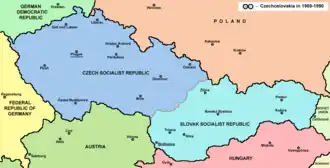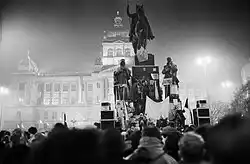
The dissolution of Czechoslovakia was a historical process which occurred in the early 1990s after the end of the Cold War and the collapse of the USSR-dominated Warsaw Pact alliance in Eastern Europe. Since the collapse of the Austro-Hungarian Empire in 1918, the region which now correlates with Czechia and Slovakia had been a single country known as Czechoslovakia. However, while closely related from an ethnic and linguistic perspective, the Czechs and Slovaks do consider themselves to be distinct people with their own culture and history. Moreover, the perception that the Slovaks had been marginalized by the more numerous Czechs within the Czechoslovak state had created resentments between the two groups. This had already found expression in 1969 when Czechoslovakia theoretically became a federal union consisting of the Czech Socialist Republic and the Slovak Socialist Republic. After the collapse of the Warsaw Pact and the move to a more democratic system, Czechoslovakia fully divided on New Year’s Eve 1992 into the Czech Republic (officially known as Czechia today) and Slovakia. Because of the harmonious nature of the dissolution, there was not an extensive movement of people between the two countries in the early-to-mid-1990s, though it did lead to some migration and demographic changes.[1]
Research your ancestors on MyHeritage
Dissolution of Czechoslovakia chronology of eventsDissolution of Czechoslovakia chronology of events
The story of the dissolution of Czechoslovakia goes all the way back to the sixth century CE when the Slavic peoples began migrating into Europe. For centuries, migration in Europe had been dominated by Germanic tribes like the Goths, Franks and Vandals who had broken through the northern borders of the Roman Empire and conquered large parts of it.[2] By the sixth century, the Germanic tribes were replaced by new waves of Slavs. This is an umbrella term and there are different Slavic groups. For instance, the Polish people of today are descended from a particular Slavic group. Two of the West Slavic groups were the Czechs and the Slovaks. There are subtle differences. For instance, while each of these groups spoke a language categorized as part of the Slavic language family, they evolved over time to speak their own dialects which in turn began languages like Polish, Czech, Slovakian and Croatian.[3]
There were distinct historic regions that developed to identify the lands of the Czechs and the Slavs. The land of the Czechs was known in medieval times and down through the early modern era as Bohemia. A Kingdom of Bohemia developed in the High Middle Ages, one which first came under the rule of the kings of Hungary, latterly becoming a territory of the Austrian Habsburgs in 1526.[4] The land which is now known as Slovakia was large known as Moravia in centuries gone by. It was variously ruled by the Austrians and as part of other states such as the Polish-Lithuanian Commonwealth. However, by the time that the Partitions of Poland were completed in 1795, both Bohemia and Moravia were ruled by the Austrians, as the Polish-Lithuanian Commonwealth was carved up between Austria, Prussia and Russia. From 1867 they were part of the Austro-Hungarian Empire.[5]
Many subject people within the Austro-Hungarian Empire retained their own languages, cultures and traditions over several centuries of being ruled from Vienna. In October 1918, as the end of the First World War was looming, with the German Empire, the Ottoman Empire, Bulgaria and the Austro-Hungarians (known as the Central Powers) about to lose, the Austro-Hungarian Empire began collapsing. A number of new states emerged out of it as it fragmented, specifically Austria, Hungary and Czechoslovakia, with additional lands accruing to a newly created Poland and to an expanded Serbia, which became Yugoslavia. Thus, after centuries of foreign domination, the Czechs and Slovaks emerged out of the First World War with their own nation state.[6]

Tensions remained between the Czechs and the Slovaks within the new state. However, these did not boil over. Instead the main enemy became Germany after the Nazis rose to power there in 1933. Their determination to acquire the German-speaking Sudetenland from Czechoslovakia led to an aggressive campaign in 1938. Although they were given the strip of land that they sought after the infamous Munich Conference of September 1938, the Germans nevertheless continued their aggression and occupied the rest of Czechoslovakia in March 1939. When the country was liberated towards the end of the war, it was done so by the Red Army and pulled into the Soviet bloc in the Cold War which followed.[7]
Tensions continued between the Czechs and the Slovaks under unified communist rule. As early as 1969, while the country remained unified, it was divided internally into a Czech Socialist Republic in the west and the Slovak Socialist Republic in the east. This laid the groundwork for the division of the country over twenty years later, as the two parts of Czechoslovakia were developing their own internal forms of self government from 1969 onwards. The Velvet Revolution of 1989 was just one of several revolutions in Eastern and Central Europe at the end of the 1980s which brought about a sundering of Moscow’s dominance and the end of communist rule in countries like Czechoslovakia.[8] As soon as the country switched to become a liberal democracy, a debate opened up about dissolving the union between the Czechs and Slovaks. This came to a head in 1992 and by the end of the year partition had been agreed upon and voted through. The dissolution of Czechoslovakia into the Czech Republic (later Czechia) and Slovakia took place on New Year’s Eve 1992.[9]
Migratory and demographic impact of the dissolution of CzechoslovakiaMigratory and demographic impact of the dissolution of Czechoslovakia
The dissolution of Czechoslovakia was a very amiable affair. As such, there were no forced population transfers and people did not feel the need to move countries to any great degree. Moreover, most Czechs already lived in the Czech Republic and vice-versa. The border also remained highly porous and people could move over and back as they wished to a large extent, a situation which had continued through membership of the European Union for both countries since 2004. Therefore, while there certainly were some few thousand people who might have moved country in the 1990s to feel more at home as, for instance, Slovak speakers in Slovakia, the dissolution of Czechoslovakia did not lead to a large amount of migration or demographic change.[10]
See alsoSee also
Explore more about the dissolution of CzechoslovakiaExplore more about the dissolution of Czechoslovakia
- Czechia, Births and Baptisms, 1637-1889 records collection on MyHeritage
- Czechia, Marriages, 1654-1889 records collection on MyHeritage
- Czechia, Church Books, 1552-1948 records collection on MyHeritage
- Czechia Newspapers from OldNews.com records collection on MyHeritage
- Slovakia, Church and Synagogue Books, 1592-1910 records collection on MyHeritage
- Slovakia Newspapers from OldNews.com records collection on MyHeritage
- Beginning Slovak Genealogy Research at Legacy Family Tree Webinars
References
- ↑ Jan Rychlik, ‘The “Velvet Split” of Czechoslovakia (1989 – 1992)’, in Politeja, No. 57 (2018), pp. 169–188.
- ↑ https://www.worldhistory.org/Migration_Age/
- ↑ https://hal.science/hal-02902087/file/Kazanski_Archaeology-Slavic%20Migrations_2020.pdf
- ↑ https://czech.mml.ox.ac.uk/static/history.html
- ↑ https://assets.cambridge.org/97805218/02536/excerpt/9780521802536_excerpt.pdf
- ↑ https://ww1.habsburger.net/en/chapters/founding-czechoslovakia
- ↑ https://www.historytoday.com/miscellanies/who-lost-czechoslovakia-communism
- ↑ https://time.com/5730106/velvet-revolution-history/
- ↑ https://www.ebsco.com/research-starters/history/czechoslovakia-splits-two-republics
- ↑ https://www.gzeromedia.com/the-velvet-divorce-at-30-how-czechoslovakia-did-what-others-couldnt

